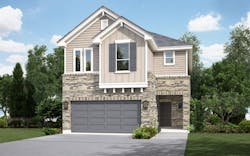Rentership, Reinvented
Homeownership has fallen to its lowest level since 1967, and it will likely continue to drop toward 60 percent. This is due to limited inventory, high prices, debt, wage stagnation, and strict lending practices. Rental households have increased by 9 million in the last 10 years.
Approximately 12.7 million of today’s 120 million households rent a detached home, with builders until recently allowing existing re-sale homes to meet the demand, says real estate consultant John Burns. Between traditional for-lease and for-sale options, single-family rentals (SFRs) are the missing layer of housing, experiencing a marked upswing during the recession with growth continuing in today’s recovery cycle. This will likely grab the attention of developers across the country.
Rental households have increased by 9 million in the last 10 years.
Rental demand is driven by a number of factors. These include people waiting longer to get married, high home prices, the inability to qualify for a mortgage, and a general lack of desire to be tied down to a home. However, many still want the lifestyle of a single-family home. As interest rates increase, we believe SFR communities will become even more attractive.
The decline in homeownership spans all age groups. Young professionals and families, move-down couples, and active adults lease single-family homes by choice. A recent article in Forbes online noted that ownership by those aged 35 to 44 decreased almost 10 percent from 2007 to 2015, the biggest decline of any age group. Wage stagnation and foreclosures have been cited as primary causes by Susan Wachter, professor of real estate and finance at The Wharton School of the University of Pennsylvania.
Amenities and features drive success
Single-family rentals have turned the market on its head with the latest building and design features: LED lighting, tankless water heaters, energy efficient appliances, high-end finishes, clubhouses, community pools, fitness centers, playgrounds, and walking trails. SFR tenants are seeking more space and privacy, yards, parking, open floor plans, walk-in closets, and two-car garages. They look for on-site property management, yard, and home maintenance.
RELATED
- What’s Driving the Demand for Single-Family Rental Homes?
- Renters Cite Affordability as the Main Obstacle to Homeownership
- Design Ideas for Single-Family Built-to-Rent Homes
Demand and growth markets are the ones to watch
Location and market dynamics also play a role in the success of contiguous SFR communities. One should look closely at job and population growth, sales prices, and lot prices. Build near schools, retail, employment, transportation, and high-growth corridor locations. The competition for good, available land sites is fierce, so it’s critical to build strong relationships with sellers and brokers. This approach starts with the land and geography. This year we began development of Village on San Gabriel, a community of 91 luxury single-family detached rental residences in Greater Austin. Our research showed us that the new site was well known for its desirability within the active adult (55+) demographic, but was increasingly becoming more popular among young families because of the city’s schools, quality of life, and charm.
Success in the SFR space requires a long-term hold investment strategy as well as management and operation of communities in a manner congruent to or better than multifamily properties, with lease up and resident retention a key focus. Partner with strategic capital that maintains similar values and is committed to serving the multifamily marketplace. This has been the blueprint for our own success.


